#Altai Trekking
Text
#altai mountains trekking#mongolia trekking#altai trekking#hiking in mongolia#trekking in mongolia#mongolia adventure tours#mongolia trekking company#altai mountains tour
1 note
·
View note
Text
Mammals of the March of Maedhros
Fish, Birds, Flowers
Flora, fauna, geography and environment Masterlist
Other world building in the Himring tag!
The March of Maedhros was a cold realm in Northeastern Beleriand. It was located slightly Southeast of Dorthonion and south of the planes and meadowlands of Lothlann and Ard Galen. The March was a cold region with taiga forested hills and icy waters, including the sources of several rivers, namely Celon and Little Gelion which were located in the other Hills around Himring.
The March falls between the cold mountains on the Southern and Eastern borders of Dorthonion and the mountainous regions of the Gap and Thargelion on its own Eastern border.
Like my other posts of this kind I will include more world building notes at the end (relationship between people/elves and the fauna, symbology or significance of certain species in local cultures, etc), otherwise this would just be a long list of species. Please always feel free to ask more about this, it’s one of my favorite topics 
Taiga and tundra: musk deer: reindeer, red squirrel, tundra wolf, altai mole, brown bear, snow vole, taiga shrew
Other forest: forest dormouse, northern birch mouse, pine marten, sable, common shrew, northern pika, moose, lynx
Hills and alpine meadow: grey marmot, forest steppe marmot, long tailed ground squirrel, wild horse, beech marten, northern badger
Northern reaches: snow leopard, wild yak, snow sheep
Throughout: red fox, brown hare, Eastern roe deer, field mouse
World building notes:
-As it’s probably obvious by the art in my background, the idea of snow leopards in the March is very important to me! Some of the most skilled among Maedhros’s captains hunted and scouted along side them and their image came to represent the ruthless, efficient and precise nature of his fighters in art and heraldry 
-I also believe that they were wild otters in the rivers specifically northern Celon,the colder one, rather unique to the region. These were far larger than common otters and well adapted to the cold. 
-Horses were brought in large numbers, including the descendants of Valinor horses. In the March they are bred for endurance, and ability to withstand the cold and train to respond to almost entirely non-verbal commands, especially by some sections of the scouts who ride them
-I always imagine a location or locations similar to Lake Baikal in Siberia, which is home the world’s only completely freshwater seal as well as cnidarian species that are not found anywhere else in the world. The seals in thr near frozen lake are abundant but are rarely slain. They are near inedible though their fat is highly useful for oils and their skins are occasionally used as well. The lake is located north of Himring and was originally the result of geologic activity in the Ered Engrin.
-Reindeer are kept by some of the Noldor and their allies in the more remote regions of the march. Their fur, skin, meat, and milk are all used.
-Pine martens and sables are dear to the Avarin groups of northeast Beleriand, some members even taking them as companions or scouts. They represent will and joy in stories and art
-I like to imagine smaller species of mammoths or woolly rhinos trek through the March on their search for fresh grass and vegetation.
As always please feel free to ask more, I really love world building and I always feel these posts are incomplete
39 notes
·
View notes
Text
There is no physical border between Kazakhstan and Mongolia. To travel from one to the other you must first cross a slither of Russia. And, ironically, according to what the local Kazakhs told me, the first of their people to roam the Mongol steppes didn't even come from Russian Kazakhstan. Apparently they were Chinese Kazakhs from the north-western province of Xinjiang, who trekked over the Altai mountains sometime around 1860, and whose motive simply seems to have been searching out fresh pasture for their animals. These remote central Asian frontiers had long been crossed back and forth by nomads who cared nothing for national boundaries, and left only the indent of their gers as evidence of having ever pitched a camp. The Kazakh pioneers swiftly found what they were seeking: horizons of ungrazed steppe, and few people to disturb them. Abbai's local history tome, a solemn navy-blue book scribed by the Russian historian G.H. Potanin, claims Kazakh patriarchs with splendid names like Kojamjar, Samur-Khan, Kulku-Shuu and Kobish-Butumsh erected their tall gers along the deserted banks of the Hovd river on the Xinjiang-Mongol border, and herded their livestock in isolation. They and their families came into contact with only a smattering of Halkh Mongol herders, and a small nomadic community who were then known as the Urianhai, but, after the 1921 Mongol Revolution, were renamed the Tuvans.
As news of this barely inhabited Mongol steppe filtered back to China, so more Xinjiang Kazakhs joined Kojamjar and the rest. Gradually Kazakhs from the Russian Altai also began to trek towards Mongolia – fleeing the October 1917 Revolution. By 1924, the year Mongolia became a sovereign state, there were more than 10,000 Kazakhs in Bayan-Olgii. And during the 1930s thousands more Xinjiang Kazakhs fled over the border to escape frequent riots in their volatile Chinese province.
For the Mongol government these new Kazakh settlers were ironically welcome, as they served a strategic purpose. They represented a buffer zone between Mongolia and China. The Mongol government was concerned about the possible break-up of western Mongolia, having already ceded territory to north-western Xinjiang. The Russian and Chinese Kazakhs were encouraged to remain on the western Mongol cusp, and in 1940 the Mongol government declared Bayan-Olgii a Kazakh autonomous area. The name Bayan-Olgii means 'Rich Cradle'.
Inevitably, as the Bayan-Olgii population expanded, some Kazakhs began an intrepid new urban life in Mongol cities and then in the capital itself. They arrived in Ulaanbaatar during the early 1950s, settling in city enclaves, and in the mining town of Nailakh, which lies 35 kilometres from the capital. Nailakh was a microcosm of Kazakhstan – the Kazakhs constructed their own wooden homes and a distinguished silver mosque. This was originally a thriving proud community with a burgeoning coal mine, but when that industry slowly collapsed, 20,000 Kazakhs were forced to survive and forage in a ghost town. The mosque was tattered and tourists accelerated past Nailak towards the nearby Terelj nature reserve, repelled by the bald gaping hillside and the scars of the mine, gouged out of the dry, heavy earth, which was now useless and obscene. By the mid-1990s most of the coal seams had been exhausted or abandoned and few Kazakhs were needed to descend the shafts. Nailakh became a slum ruined by boredom, dereliction and despair.
The Kazakhs of Nailakh, Ulaanbaatar and Bayan-Olgii have always lived uneasily alongside their Mongol neighbours. Many of the Mongols, agitated and threatened by Kazakh patriotism and especially their religion, casually branded the Kazakhs as dirty, potentially dangerous Muslims. In response to this insiduous contempt, the Kazakhs made little effort to integrate with the Mongols, choosing to remain separate linguistically, culturally and religiously. Despite spending more than a century in Mongolia, the vast majority of Kazakhs have remained in Bayan-Olgii, as far from Ulaanbaatar as possible. In Ulaanbaatar the Mongols usually refer to Bayan-Olgii with a grimace. “It's a foreign country to us,” more than one of my Mongol friends told me before I'd even thought of moving to Tsengel. “We don't trust those Kazakhs. Zowan [dirty]. If you ever go there, you'll be kidnapped and taken as a bride for a Kazakh herder, you know. It's a dangerous place.”
When the Kazakh government dramatically appealed to its Mongol brethren to return to their newly independent homeland at the end of 1991 and boost the Kazakh population, the response was momentous. The temptation of finally belonging to a land of their own had a magnetizing effect on the 120,000 Mongol Kazakhs, and by 1994 almost half of them had flown, driven or trekked to Akmola and beyond, abandoning their fragile Mongol inheritance for a new life over the mountains. It's easy to understand why they left: they'd never had a homeland before, the newly democratic Mongol economy was floundering in comparison to Kazakhstan, and most of the Mongols had never wanted the Kazakhs in their country in the first place. Elia, Marat-Khan and their extended family had all reinvented their lives in that better land, which every Kazakh I had met in Mongolia referred to as his or her spiritual home.
Over the last nine months I'd slowly become used to hearing the scathing comparisons between Tsengel and Kazakhstan, between Mongolia and Kazakhstan. Even, and maybe especially, those who'd never set foot outside Bayan-Olgii province, assured me Kazakhstan was the land of plenty. Alma-Ata means 'City of Apples', and long before I spent that evening talking with Elia I'd often listened to other Tsengel Kazakhs lovingly describe the wealth of fruit and vegetables, motor cars, apartments with colour TVs, stocks of lavish food and laden market stalls of Kazakhstan. Zulmira, Princess, Abbai, the teachers at school, the shopkeepers and the Imam himself had all told me the same sublime tale.
But in spite of this abundance, these apparent opportunities and this potential new life in their own nation, the brutal irony is that so many of the Mongol Kazakhs who left Mongolia in the 1990s have already returned. Bruised by unashamed they've trekked back over the Altai mountains to their barren refuge on the edge of Mongolia. After their long expensive pilgrimages to Kazakhstan, after uprooting their families and abandoning their homes, they discovered that even in their own land they're still considered a minority, and not a particularly liked or welcome minority at that. Of the approximately 17 million people living in Kazakhstan, just under half are ethnic Kazakhs, with the rest of the population made up of mainly Russians and Ukrainians, plus Germans, Uzbeks and Tatars.
In Kazakhstan the Mongol Kazakhs are still widely regarded as immigrants. Initially encouraged by the Kazakh government to settle and work in the underpopulated, windswept northern Kazkh oblasts, where mainly Russians lived, they were immediately regarded with suspicion and treated not as Kazakhs but Mongols who spoke Kazakh. Foreigners laying claim to a land which was not theirs by right. The Russians, Ukrainians, Uzbeks and Tatars already owned part of the history of Kazakhstan, and had nothing to gain from living amongst newly settled Mongol Kazakhs. When the Kazakh economy began to flounder in 1996, many of the Mongol Kazakhs, who like immigrants everywhere were employed in low-paid manual work, quickly lost their jobs. And as Nazarbaev's government struggled with a crippling and unpopular reform programme, state pensions also dried up. But most intransigent and ironic of all, the Kazakhs' nomadic herding life, which has thrived in the harsh Mongol Altai since the middle of the last century, has been almost curtailed in Kazakhstan itself.
Long before Kazkah independence the Russians were already intent on urbanising this land and exploiting its vast mineral resources. The compulsive building and then expanding of factories and surrounding new towns and cities has reached endemic proportions since 1991 as Kazakhstan has sought out industrial wealth. The nomads, who've stoically continued with traditional herding lives in the face of this concreting over of their land, have found themselves increasingly living on the edge of a nation that does not value them any longer.
“No, there aren't many herders left in Kazakhstan,” Elia told me that evening. She sounded pragmatic, there was no trace of regret in her voice. “Most of us live in the cities. Most of the Kazakh nomads live here, you know, in Bayan-Olgii [the Rich Cradle].”
— Hearing Birds Fly: A Nomadic Year in Mongolia (Louisa Waugh)
#book quotes#louisa waugh#hearing birds fly: a nomadic year in mongolia#history#migration#ethnicity#culture#racism#islamophobia#prejudice#immigration#class#poverty#economics#industry#mining#herding#livestock#islam#october revolution#mongolian revolution of 1921#mongolia#kazakhstan#china#bayan-ölgii province#ulaanbaatar#indigenous siberians#kazakhs#tuvans#nursultan nazarbayev
2 notes
·
View notes
Text
Travel Agency in Uzbekistan: Unlock the Ancient Silk Road
Uzbekistan, a land of cultures, is gradually emerging as a tourist destination due to its Silk Route cities like Samarkand, Bukhara, and Khiva. Tour operators in Uzbekistan allow tourists to visit historical sites such as mosques, mausoleums, and bazaars.
Regarding flight and accommodation bookings and transport arrangements, Travel Agency in Uzbekistan ensures that tourists can explore the country’s cultural and architectural wonders comfortably. Even many agencies also arrange adventure tourism; for instance, the Aral Sea tour or the hiking in the Tian Shan Mountains so the agencies offer numerous services to all kinds of tourists.
Travel Agency in Kyrgyzstan
Kyrgyzstan is popular for its scenic beauty, including magnificent mountains and beautiful water bodies, including Issyk-Kul. Travel Agency in Kyrgystan work much on adventure and eco-tourism offering trekking and camping, horseback riding, and other tours across the natural territories of Kyrgyzstan. Numerous agencies also offer cultural interactions and tours, which enable guests to interact with nomadic culture and the Kyrgyz people.
From sightseeing in the capital city of Bishkek to hiking in remote areas, the travel agencies in Kyrgyzstan guarantee well-coordinated organization and genuine experiences.
Travel Agency in Kazakhstan
Kazakhstan, the largest country in Central Asia is a country of dual characteristics, urban centers of Almaty and Nur-Sultan and the expansive steppes and mountains. The Travel Agency in Kazakhstan provides different services such as city and countryside tours, cultural tours, and others. These agencies offer packaged services for all tourists whether on business or leisure; whether you want to tour the new architectural designs of the newly built capital city, Nur-Sultan, or take a hike in the Altai Mountains.
Kazakhstan, which is a country that has both, big cities and wild nature, is one of the most popular destinations for tourists, and the local travel agencies make the tourists’ stay as interesting as possible.
Conclusion
Specialized travel agencies in the countries of Uzbekistan, Kyrgyzstan, and Kazakhstan provide services focused on individual attractions of each country. From history enthusiasts to adventure seekers and everyone in between, these agencies offer well-organized travel solutions for every kind of traveler in Central Asia.
0 notes
Text

The world of Jih's Journey is getting bigger, with two new announcements on the way! Here's the second.
Alone, but no longer afraid, Ozul recalls the last moments shared with his friends, Deeso and Zulag on the Caucasus Mountains. Now with a new calling, Ozul joins the rest of the Forest Seeker band in their search for a new home. Ozul finds himself in company with a young companion named Susa who searches for their claimed ancestral home of Denisova Cave. With only themselves to rely on, the pair begin the long trek to live their new destiny. Return to the world of Jih's Journey once more through the eyes of Ozul. Fresh from his adventures in Jih's Journey, prepare for a chilling experience along the Altai steppe and Russian tundra. Thrills, chills, and the ancestral homeland await. Will you heed its call?
1 note
·
View note
Text
Journey Through the Heart of Mongolia: Exclusive Tour Packages and Altai Mountain Adventures
Nestled between vast steppes and towering mountains, Mongolia remains one of the last bastions of untouched wilderness and ancient nomadic culture on Earth. For the intrepid traveler, Mongolia offers a stark contrast to the familiar, a place where adventure is woven into the fabric of the landscape. Through a variety of Mongolia Tour Packages and the Mongolia Altai Mountain Tour, visitors have the unique opportunity to explore this rugged land in-depth, experiencing its natural wonders and the enduring traditions of its people.

Cultural Insights and Historical Explorations
The best Mongolia Tour Packages delve into the rich tapestry of Mongolian history and culture. Visitors can wander through the ruins of Karakorum, the ancient capital of the Mongol Empire, or experience the spiritual tranquility of Buddhist monasteries that dot the landscape. These tours not only illuminate Mongolia’s glorious past but also bring travelers face-to-face with the vibrant cultural traditions that are still alive today. From witnessing the incredible skill of eagle hunters to participating in the daily lives of nomadic herders, these experiences provide a profound understanding of the enduring Mongolian way of life.
Introducing the Mongolia Altai Mountain Tour
For those drawn to the call of the mountains, the Mongolia Altai Mountain Tour offers an unforgettable adventure. The Altai Mountains, a majestic range stretching across the western part of Mongolia, are known for their rugged beauty and the diverse ecosystems they encompass. This tour is a dream come true for hikers, nature lovers, and photographers alike, offering breathtaking landscapes from glacial peaks to rich, verdant valleys teeming with wildlife.
Adventures in the Altai Mountains
The Mongolia Altai Mountain Tour is more than just a trek; it is an expedition into the heart of Mongolia’s wilderness. Participants get the chance to traverse remote paths, camp under the stars, and observe rare wildlife species in their natural habitats. The physical challenge of hiking through the Altai is rewarded with panoramic views and the serenity of untouched nature. This tour not only challenges the body but also enriches the soul, offering deep, reflective experiences amidst some of the most spectacular scenery on the planet.
Connecting with Mongolia's Landscape and Legacy
Both the Mongolia Tour Packages and the Mongolia Altai Mountain Tour offer gateways to understanding Mongolia’s complex tapestry of history, culture, and natural beauty. These tours provide a broad spectrum of experiences that highlight both the ancient traditions and the majestic landscapes of Mongolia. They invite travelers to not just see Mongolia but to engage with it, offering deeper insights and lasting memories.
Conclusion
Mongolia is a land of diversity and contrasts, where ancient traditions meet breathtaking landscapes. Whether it’s through the expansive Mongolia Tour Packages or the focused Mongolia Altai Mountain Tour, there are endless opportunities to explore and connect with this unique country. For those ready to embark on a journey of discovery, further details and booking information can be found at westernaltai.com, your guide to the wonders of Mongolia.
0 notes
Text
The 8 Mind-Breaking Places to Visit in Kyrgyzstan
Take a journey across Kyrgyzstan's amazing landscapes and cultural valuables, where every turn reveals a weaving of delights that engage the spirit. Kyrgyzstan attracts with its unbelievable array of experiences, from the amazing beauty of Issyk-Kul, the second-largest highland lake in the world surrounded by snow-capped peaks, to the ancient mysteries shrouding the Silk Road capital of Osh. Explore the strange scenery of the Tian Shan mountains, where green valley's give way to rocky canyons and beautiful glacial lakes and get a taste of the Kyrgyz people's nomadic ways amid Song Kol's grasslands filled with yurts. Get ready for an experience that will exceed your expectations and leave a lasting impression on your soul.
With our premium Kazakhstan tour packages, you can set out on incredible journey through country's expansive landscapes and unique cultures. Our Kazakhstan holiday packages, which are customised to each traveller's interests and preferences, provide an effortless fusion of adventure, culture, and relaxation. Explore historic Silk Road cities of Turkestan and Shymkent, colourful bazaars and centuries-old monuments attract you with stories of ancient periods. Experience the natural beauty of the Altai Mountains or the calm shores of Lake Balkhash for those who love the great outdoor. Exciting outdoor activities await you among incredible scenery. You're looking for peaceful getaway, thrilling adventure, or cultural immersion, our Kazakhstan holiday packages guarantee an amazing experience that will amaze and inspire you.
Here are the 8 Mind-Breaking Places to Visit in Kyrgyzstan:
Lake Issyk-Kul:
The beautiful mountain lake known as Lake Issyk-Kul, or "Warm Lake," can be found away among the Tian Shan Mountain range. It is an important part of Kyrgyzstan's geography and culture, and it is second-largest alpine lake in the world. Issyk-Kul offers extensive variety of activities for relaxation, including swimming, tanning, boating, fishing, and yachting, thanks to its clean water, sandy beaches, and calm atmosphere.
Ala Archa National Park:
Ala Archa National Park is nature lover's dream come true, offering variety of environment such as alpine meadows, lush woods, icebergs, and towering hills. It is only a short drive from Bishkek, the capital city. Numerous outdoor activities are available in the park, hiking, trekking, rock climbing, picnics, and wildlife observation. Numerous trails are available for exploration, including the difficult Ak-Sai Glacier, the beautiful Ratsek Hut, and the amazing Ala-Kul Lake excursion, which offers expansive views of the neighbouring mountains.
Osh:
Osh, one of the oldest cities in Central Asia, is rich in culture and history, having been around for more than 3,000 years. Situated in the lush Ferghana Valley in the southern region of Kyrgyzstan, Osh presents an extensive variety of backgrounds, lively marketplaces, and historic sites. UNESCO-listed Sulaiman-Too Sacred Mountain, Muslim pilgrimage site and symbol of religious value, is the city's most popular attraction.
Song Kol Lake:
Situated in the high-altitude plateau of Naryn Province at 3,016 metres above sea level, Song Kol Lake is an amazing mountain lake that is well-known for its amazing natural beauty and traditional customs. Song Kol, surrounded by rolling hills, beautiful meadows, and snow-capped peaks, provides tourists with a rare chance to experience genuine nomadic Kyrgyz culture.
Karakol:
Karakol is a stunning town that is well-known for its historical sites, different cultures, and outdoor activities. It is located at the easternmost point of Issyk-Kul Lake. Karakol, which was first established in the 19th century as a Russian military outpost, has developed into a thriving cultural hub that is influenced by Kyrgyz, Russian, and Dungan traditions. Among town's architectural attractions is beautiful Dungan Mosque, which was constructed in traditional Chinese style using no nails at all.
Skazka Canyon (Fairy Tale Canyon):
Hidden away in Kyrgyzstan's Issyk-Kul area, Skazka Canyon, sometimes called Fairy Tale Canyon, is a natural wonder famous for its bright colours and unique rock formations. The canyon's high sandstone mountains, colourful formations, and layers of sedimentary rock in shades of red, orange, and yellow, carved by ages of wind and water erosion, create an invisible scene suggestive of a realm from fairy tales.
Tash Rabat Caravanserai:
Tash Rabat Caravanserai, which is hidden away in the isolated mountains of Naryn Province, is a monument to Kyrgyzstan's rich past as crossroads of civilizations along historic Silk Road. Stone caravanserai dates back to 15th century and was an important resting place for traders, merchants, and tourists making their way through dangerous mountain passes that connect China with Central Asia.
Sary-Chelek Biosphere Reserve:
The Sary-Chelek Biosphere Reserve is a pure wilderness area known for its biodiversity, graphic beauty, and conservation activities. It is situated in the unspoiled highlands of Jalal-Abad Province. Reserve, which is home to rare and endangered species like snow leopard, lynx, and golden eagle, is made up of thick woods, mountain meadows, and beautiful lakes.
Conclusion:
As your time in Kyrgyzstan comes to a conclusion, the variety of experiences this beautiful country has to offer will leave you speechless. For every traveller fortunate enough to venture into its depths, Kyrgyzstan creates lasting impact, from rough beauty of mountain ranges to warmth of its kind people. Take with you the memories of this land of infinite wonder, it's strange landscapes, its rich history of culture, and the deep bond that is formed between visitor and location as you wish it farewell. With every visit, Kyrgyzstan encourages travellers to come back and explore mysteries once more. For more details visit best travel agency in Dubai
0 notes
Text
Discover Mongolia: An Intimate Journey Through the Enthralling City of Altai
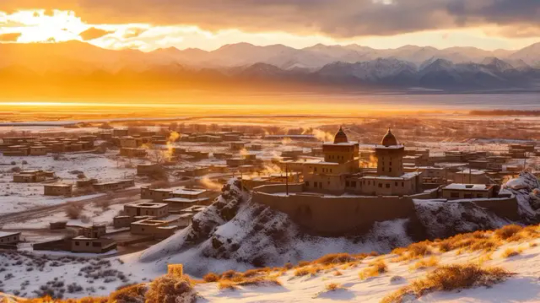
Mongolia, the land of blue skies, is a majestic realm filled with uncharted frontiers, untamed landscapes, and the treasures of rich culture and history. Among its many hidden jewels, the city of Altai gleams with a charm that's unique, rare, and captivating. Let’s dive deep into the world of Altai city tourism and discover the marvels it holds.
A Glimpse of Altai City: Where Culture Meets Adventure
Tranquilly perched amidst the expansive Mongolian steppes, Altai city serves as a portal to a world that’s far removed from the ordinary. This indigenous city blends the vibrancy of culture, the intrigue of history, and the allure of nature in a single tapestry, offering a wealth of experiences that range from tranquil to thrilling.
Embarking on Adventure: Things to do in Altai City, Mongolia
In Altai, each day unfurls a new adventure. Start your day with a breathtaking view of snow-capped mountains from your hotel room. Go horseback riding through the beautiful landscapes or trailblaze your way to thundering waterfalls. Maybe even set up camp under a captivating starlit sky. The abundant outdoor activities in Altai, Mongolia, are sure to satiate your wanderlust.
Experience the Thrill of Altai Adventure Sports
Altai city is a haven for adventure sports. From trekking through beautiful terrains, camping under the clear skies, paragliding over the stunning landscapes to horse riding through its vast plains - the city offers plenty of ways to feel the rush of adrenaline. Altai is a must-visit for every adventure enthusiast out there.
Time Travel in Altai: Dive into the Colorful History and Culture
Altai is a living testament to Mongolia’s rich history that stretches back over millennia. The city's vibrant markets whisper tales of its glory days as a part of the Silk Road. Its local museums are treasure troves of artifacts, offering glimpses into an era when Altai was a cultural and trading hub.
Food for the Soul: Taste the Authentic Cuisine of Altai City, Mongolia
Every corner of Altai city is filled with the delightful aroma of local cuisine that's unique, traditional, and mouthwatering. Try the local favorite Khuushuur - a delicious meat-filled pastry, or sample the hearty Guriltai Shul - a delectable noodle soup - at one of the many local restaurants. The gastronomic journey is an integral part of the Altai city Mongolia experience.
Key Takeaways for the Enthusiastic Traveler
Altai city, Mongolia offers a myriad of experiences that cater to all kinds of travelers. Whether you are a history enthusiast, a culture vulture, or an adventure junkie, Altai promises to be a thrilling chapter in your travelogue. Here are a few key points to remember:
- Best time to visit: The weather in Altai city, Mongolia is best for outdoor activities between May and September.
- Shopping: The vibrant markets of Altai city are a shopper's paradise, offering locally made artifacts and souvenirs.
- Festivals: Altai city, Mongolia festivals are a riot of colors, music, and dance that showcase the rich cultural heritage. Make sure to check the dates and plan your visit accordingly.
- Travel Guide: For detailed information like 'Altai city Mongolia map', 'Hotels in Altai City Mongolia', 'Altai City Mongolia Flights', and 'Altai city Mongolia travel packages', refer to trusted travel guides or contact local travel agencies.
So, when are you packing your bags for the mesmerizing city of Altai, Mongolia?
Note: This article is based on the author's personal exploration and experiences. For more specific information, kindly refer to reliable travel sources or contact travel agencies.
Read the full article
1 note
·
View note
Text
Beauty and Weather of Mongolia: Exploring the Unique Features and Climate

Mongolia is famed for its wide and breathtaking landscapes, rich history, and distinct culture. It is also known for its unusual weather conditions, which can range from burning hot summers to freezing frigid winters.In this article, we will explore the natural beauty of Mongolia and how the mongolia weather and climate shape its unique features.
1. The Natural Beauty of Mongolia
Mongolia has a diversified terrain, with towering mountains, enormous deserts, rolling grasslands, and crystal-clear lakes. Mongolia has been a popular destination for adventurers and travellers seeking to immerse themselves in its breathtaking beauty as a result of these natural beauties.
The Gobi Desert, which spans much of Mongolia, is one of the country's most famous natural wonders. The desert is home to rare flora and species, such as the elusive snow leopard, Bactrian camel, and Gobi bear.
The vast expanse of the Gobi Desert is dotted with breathtaking rock formations, sand dunes, and ancient ruins.
The Altai Mountains, located in the western region of Mongolia, are another natural wonder. The Altai Mountains' lofty peaks are home to a variety of species, including the endangered argali sheep and snow leopards. The mountains also provide beautiful views and fantastic trekking opportunities.
2. The Climate of Mongolia
Mongolia has a continental climate, which implies that it endures considerable temperature changes throughout the year. The country features four distinct seasons, each with its own weather patterns.
Summer in Mongolia can be blisteringly hot, with temperatures reaching up to 40 degrees Celsius in some regions of the nation. Summer's dry heat is ideal for exploring large landscapes and partaking in outdoor activities like hiking and camping.
In contrast, winter in Mongolia is severely cold, with temperatures as low as -40 degrees Celsius in certain locations. The harsh winter weather might make travel difficult, but it also allows for traditional Mongolian winter sports such as ice fishing, sledding, and horseback riding.
Mongolia's spring and autumn seasons are comparatively warm, making for a nice climate for visitors. Spring is the finest time to see Mongolia's wildflowers blossom and experience the nomadic lifestyle. Autumn is the ideal season for exploring the country's gorgeous fall scenery and attending traditional celebrations like the Golden Eagle Festival.
3. The Unique Features of Mongolian Culture
The peculiar culture and traditions of Mongolians are a result of the country's severe weather. Since they have always coexisted peacefully with nature, Mongolian nomads have created a vibrant culture that honors the natural environment.
The nomadic way of life is one of Mongolian culture's most defining characteristics. The lifestyle of nomadic herders, who move their animals around in search of grazing areas, has mainly not changed throughout the years.
By sleeping in a ger, a traditional Mongolian house, and taking part in daily activities like milking cows, producing cheese, and riding horses, visitors to Mongolia can experience this ancient way of life.
The traditional cuisine of Mongolia is another distinctive aspect of its culture. Mutton, beef, and horse meat are common ingredients in Mongolian cuisine, which is robust and filling.
Attending a Mongolian barbeque, where meat is cooked over an open flame, or tasting dairy items like airag (fermented mare's milk) and aaruul (dry curd), will allow visitors to enjoy traditional Mongolian food.
Conclusion
Mongolia is a land of breathtaking natural beauty, harsh climate, and distinctive cultural traditions. Nature of the nation.
1 note
·
View note
Photo

Planning a trip may sound easier, but it is actually easier said than done. Planning a trip requires a lot of organized efforts. Without appropriate planning, you may miss out on the real beauties of Mongolia. The travel agencies come to help here. They can help in planning you the best trips and include all the main highlights of the Altai Tavan Bogd National Park in your package.
For the best travel experience in Mongolia, visit at our site.
1 note
·
View note
Photo

Mountain climbing tour :
Altai Expeditions is a leading adventure tour company specialize in Mountain climbing tour. We offer fully guided expedition all peaks and provide logistic support to climber around Russia, China, Kazakhstan, Malchin , Niaramdal, Naran, Snow church and Olgii, and Mongolia’s longest glacier, Potanin, 19 km long.
0 notes
Text




Altai Mountains
#altai#altai mountains#russia#russian nature#multinsky lakes#chuysk road#trekking#trip#mountain trip#campfire#original photographers on tumblr#original photogtraphy
68 notes
·
View notes
Photo
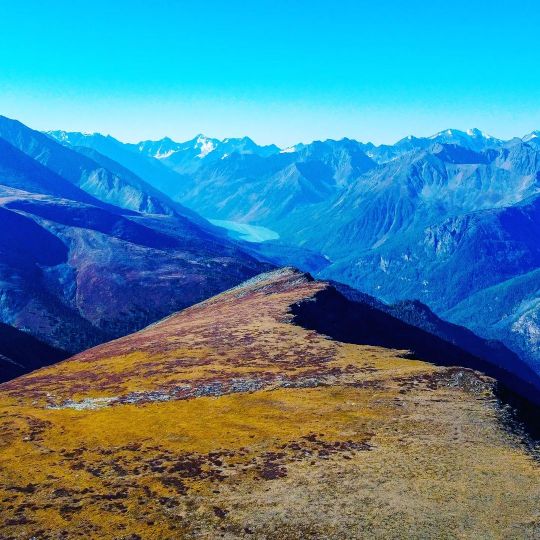
Вид на долину Кучерлы и Кучерлинское озеро с тропы на Кара-Тюрек #алтай #кучерла #горы #походы #путешествия #стоветров #хребет #долина #голубаядаль #сибирь #горныйалтай #altai #altay #mountains #outdoor #trekking #backpacking #hiking #autumn #siberia #aerial #dji #mavic #mavicmini #travel (at Кучерла) https://www.instagram.com/p/CUt2tGej36Y/?utm_medium=tumblr
#алтай#кучерла#горы#походы#путешествия#стоветров#хребет#долина#голубаядаль#сибирь#горныйалтай#altai#altay#mountains#outdoor#trekking#backpacking#hiking#autumn#siberia#aerial#dji#mavic#mavicmini#travel
6 notes
·
View notes
Text
Trekking in Western Mongolia
I’ve just returned from a unique trip to the very western edge of Mongolia, where for the last three weeks we trekked by foot, horseback and canoe. Along the way we visited local nomads in their winter homes and summer gers (the Mongolian word for yurts).
The trip was organized by Tim Cope from Australia, a well known traveller and adventurer, together with O.A.R.S. from the US.
Our group of 10 men and women from the US and Australia were supported by an array of guides, drivers, horsemen, camel packers, cooks and more. The crew members changed over the weeks depending on the needs of that portion of the trip. Along the way our gear was carried by Russian 4WD vans or camels depending on the availability of roads. (A road being defined as two or more generally parallel tracks.)
The scenery was stunning and while the trekking, canoeing and riding required a fair amount of daily effort, it was doable by our group which ranged in age from 38 to 82.
The logistics and nature of the travel together with the range of terrain means that only about 30 people have ever done this trip, so this was clearly a rare opportunity.
Days 1 - 3: Getting to the start of the trek.
We all met in Ulaanbaatar in mid-August for a final review of the upcoming trip, distribution of additional gear, last minute purchases and repacking our clothes and gear for the trek. (Little did we know that re-packing for changing circumstances was going to be an almost daily event.) The following morning we flew to Ölgii in western Mongolia where we loaded into 4WD vehicles for a two days of overland driving to get to the start of the trek.
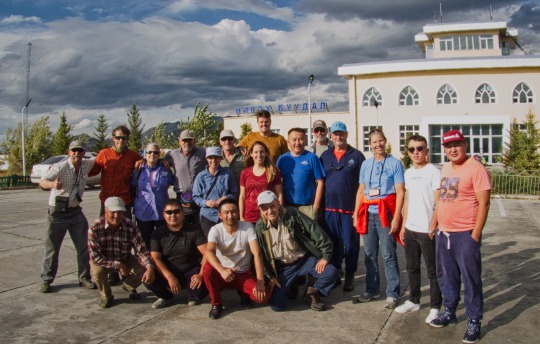
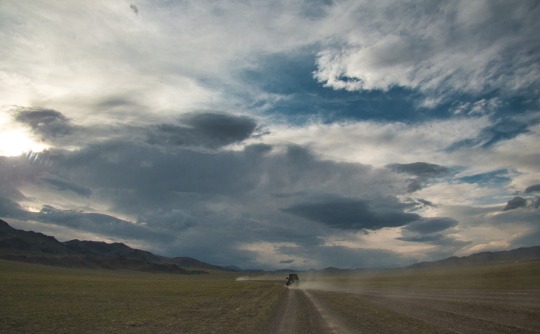
Our first camp was on the open steppe west of Ölgii near a nomad camp. We were rewarded by spectacular evening light across the step and hills including a bright shaft from a rainbow; an excellent omen for the trip.

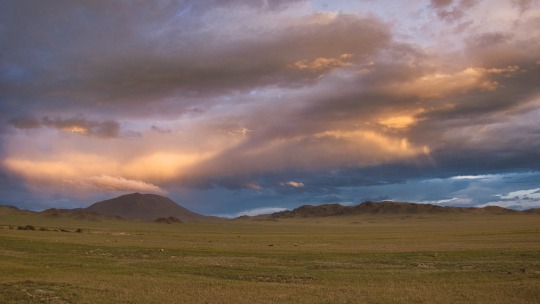
In the morning we found we had set up camp around the burrow of a long-eared Mongolian gerbil. When it first stuck its head out of the burrow, we all thought “rabbit”, but then it came out and that wasn’t a rabbit’s tail!

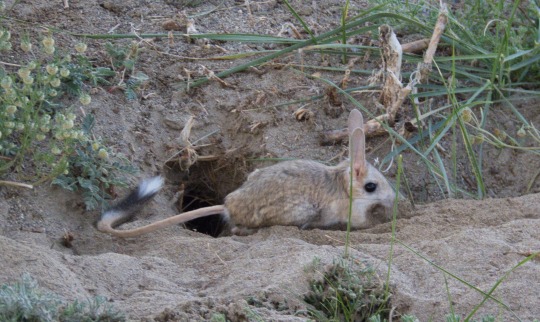
Our first stop after packing up was to visit the nomad family we were camped near. This was to be a daily activity throughout the trip. It is considered good fortune among the nomads to invite visitors into your home and we were always graciously invited in and served the standard food and drink.
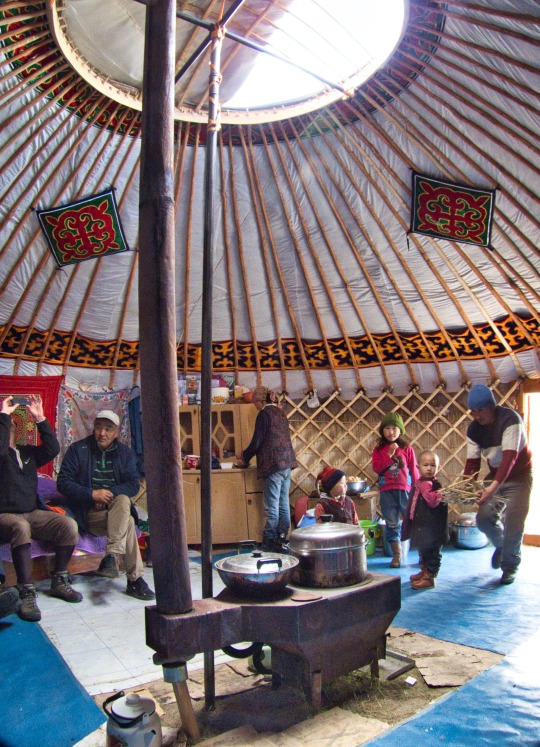
The main item offered is always milk tea. This is not tea with added milk, but milk boiled on the stove with added tea leaves, served in bowls. Despite the size of our group (usually about 14 including guides and such) sufficient bowls were always found. The low table was always loaded with butter, dried curd, and small fried breads. To this might be added cheese, yogurt, thick cream, or berry jam. All of this would have been home made.
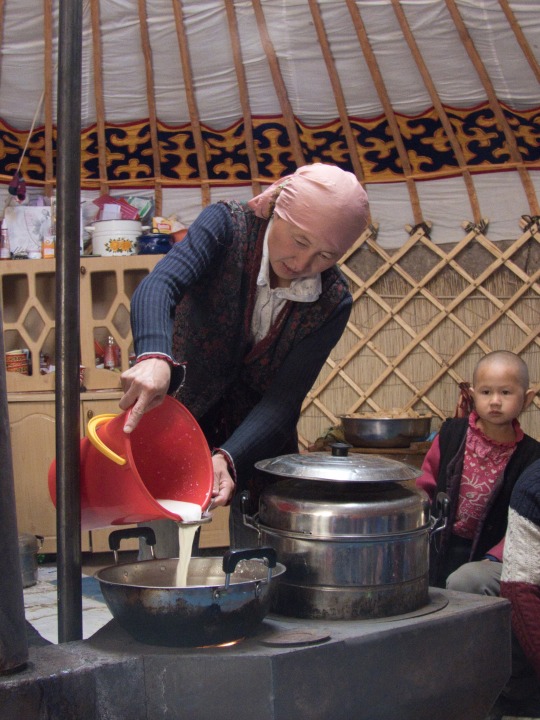
Interestingly this far western end of Mongolia is mainly settled by Kazakh nomads with some Mongolians and Tuuvans. The Kazakhs typically don’t speak Mongolian and the Mongolians don’t speak Kazakh, although the Tuuvans seem most likely to speak both. This is despite the fact that the groups may be in the next valley from each other.
After drinking the tea and tasting the offerings on the table, we gave them some small gifts and loaded up for a long drive up into the mountains.
We stopped for lunch alongside a vacant nomad winter home. The fall, spring, and winter homes are usually solid structures rather than gers with structures for protection from the wind for the animals. You may have noticed that were are almost no trees here, so fuel isn’t typically firewood, but manure, usually cow or yak. In fact, manure is the fuel for all cooking and heating, although some families had a small pile of kindling.
This pile of dried manure was unique for having a fresh camel’s head on top!
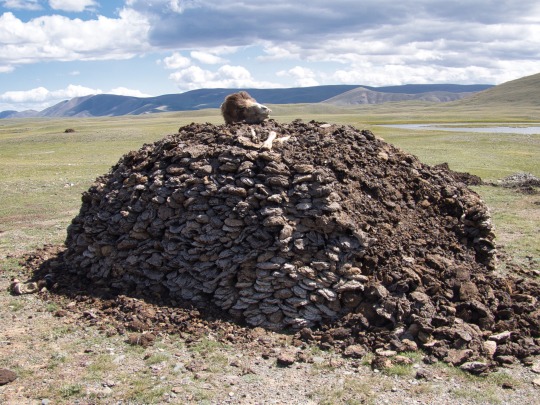
A second stop was at a stone outcropping covered with petroglyphs; the typical hunted animals, hunters and horses.
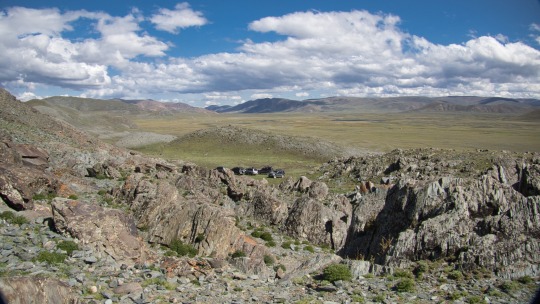
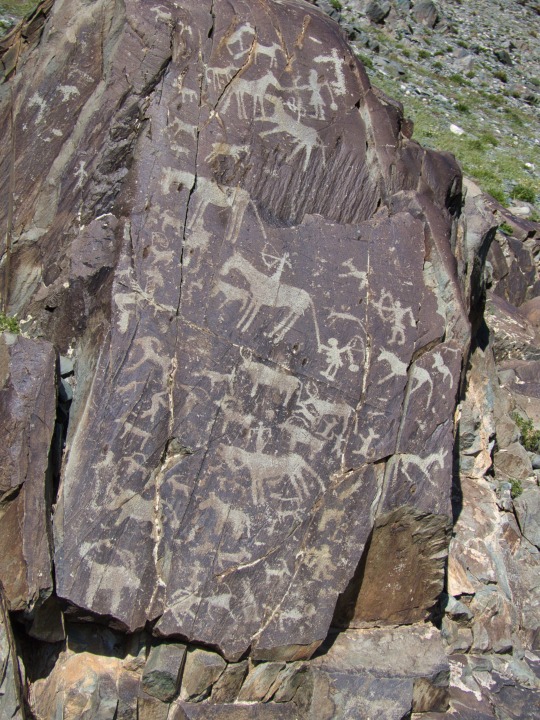
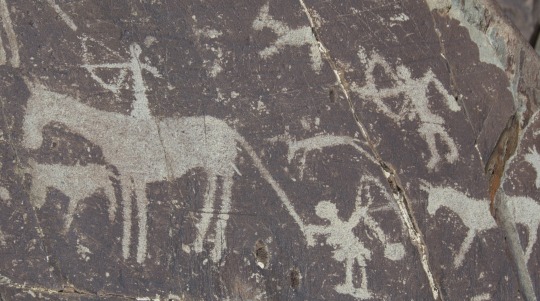
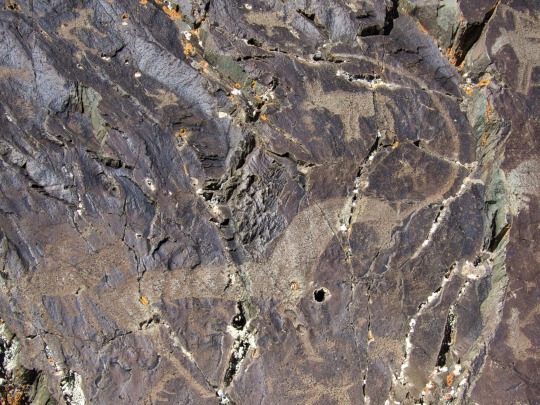
We also saw our first ancient graves. These were mound graves and are thousands of years old. The size of these mounds makes it clear that these were important people.
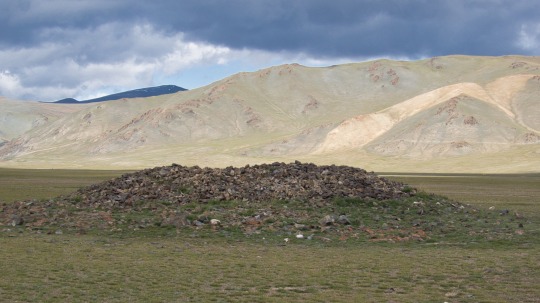
As we drove up into the mountains we found ourselves in a snow storm, which was certainly a concern. While we were all prepared for cold weather and possible snow, camping in snow always increases the concerns about cold and wet conditions.
But by the time we got to the campsite in the Altai Tavan Bogd National Park the snow had stopped and we found it had only persisted on the surrounding slopes creating a stunning scene.
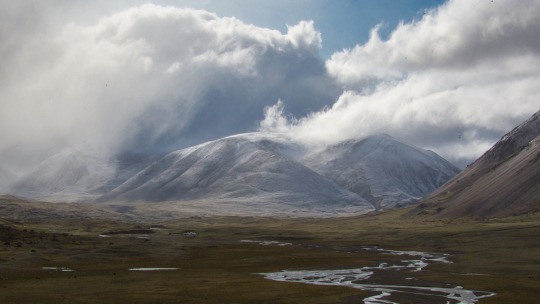
5 notes
·
View notes
Text
Exploring Mongolia’s Rich Traditions: Golden Eagle Festival and Altai Trekking Tours
Mongolia, a land of unspoiled beauty and ancient customs, offers unique cultural experiences that draw adventurers and culture enthusiasts alike. Among these experiences, the Golden Eagle Festival and Hunting Tour and the Altai Trekking Tour in Mongolia stand as pillars of traditional Mongolian heritage and natural exploration, presenting a captivating blend of cultural immersion and adventurous escapade.

Golden Eagle Festival: A Cultural Phenomenon
The Golden Eagle Festival and Hunting Tour begins with the thunderous applause of spectators and the fierce gaze of golden eagles perched regally on their handlers’ arms. This festival, held annually in the rugged steppes of Mongolia, celebrates the age-old tradition of eagle hunting. Participants, known as berkutchi, display their skills in controlling these magnificent birds of prey, which are trained to hunt foxes and hares. The festival not only showcases traditional Kazakh eagle hunting techniques but also includes cultural exhibitions, such as horse racing and traditional music, providing a comprehensive glimpse into the nomadic lifestyle.
Significance of the Golden Eagle Festival
The Golden Eagle Festival and Hunting Tour transcends mere entertainment, embedding deep cultural significance and preserving Mongolian heritage. It offers an opportunity for locals and tourists to reconnect with centuries-old traditions that have been passed down through generations. This festival is not just a competition; it's a vibrant celebration of cultural identity, strength, and the deep bond between the eagle and its master.
Altai Trekking: A Journey Through Nature
Moving from the cultural plains to the high altitudes, the Altai Trekking Tour in Mongolia offers an entirely different but equally mesmerizing experience. This trek takes adventurers through the Altai Mountains, one of Central Asia’s most spectacular and least visited areas. The rugged terrain, vast landscapes, and the silence of nature provide a stark contrast to the lively eagle festival, offering tranquility and a chance to reconnect with nature.
Exploring the Majestic Altai Mountains
During the Altai Trekking Tour in Mongolia, trekkers encounter diverse landscapes, from glacial valleys and high mountain passes to lush green meadows and pristine lakes. The trek not only challenges the physical capabilities of the adventurers but also offers them unparalleled opportunities to witness the rich biodiversity of the region, including rare species such as the snow leopard and the Argali sheep. This tour is a must for those who wish to explore the untouched beauty of Mongolia and indulge in the thrill of high-altitude trekking.
Connecting Traditions and Nature
Both the Golden Eagle Festival and Hunting Tour and the Altai Trekking Tour in Mongolia provide unique insights into the soul of Mongolia. Whether it’s witnessing the powerful bond between man and bird or traversing the mighty Altai ranges, these experiences highlight Mongolia’s cultural depth and natural wonders. Each tour offers a different perspective of the country’s heritage and landscape, appealing to those who seek cultural depth and adventure in their travels.
Conclusion
For those drawn to unique cultural experiences and breathtaking natural explorations, Mongolia offers the perfect blend of both. The Golden Eagle Festival and Hunting Tour and the Altai Trekking Tour in Mongolia are not just tours; they are gateways to understanding the Mongolian way of life and the untouched beauty of its landscapes. For more information and to plan your adventure in the heart of Central Asia, visit westernaltai.com, where the spirit of Mongolia awaits.
0 notes
Text
[Back in the 1970's, when they did their fieldwork, shamans still existed, just. "Despite all the Russians did," said the Altai lady, "shamanism survived— in secret, underground. It never became extinct because there was always a succession, a teacher who might take you on as an assistant. But, of course, genuine shamans were very few." Native Siberians could be persuaded to discuss shamanism, the Ket lady chipped in, only after long preliminaries. Once, she had managed to lead a conversation all the way from ski-design to the 'seven drum system', whereby shamans graduated to stronger instruments as they perfected their soul-journey technique, and back to weaker ones as they grew old and frail themselves. She smiled at the memory. 'When I understood I wanted to rush out and stand on my head! It was a marvelous moment!' Though it was still not possible openly to discuss such findings, 'you could put things so that other people in the field understood. One of the tricks was to write in the past indefinite, even though you had gathered the information that very year. It was a way of protecting your informants, in case some Party fool read it and made trouble.' As for finding shamans today, neither woman held out much hope. Real shamans did not talk to strangers, and the new breed were a waste of time. They had been to see a Sakha so-called shaman perform at the Palace of Sport: 'He had the coat, the cap, the drum. But it was just a performance. There was nothing genuine about it.’
Attending a conference on shamanism in Moscow, I began to worry that the Petersburg ladies might be right. Though organised by the Academy of Sciences, it was funded by Californian shamanists of just the sort they despised. Before lunch, earnest Russian Academicians delivered weighty papers on Sami Chants and Sakha epics. After lunch, even more earnest Americans took to the rostrum with 'bio-extrasensories', 'super-abilities', and 'psy-surgery'. At the back, ostentatiously bored, sat a row of real live shamans— plump, middle-aged Asian women, tricked out in nylon robes, neo-Celtic jewelry and gypsy scarves. Everyone woke up slightly for Dr. Michael Harner, the renegade academic anthropologist who, having tried out his Ecuadorean subjects' hallucinogens back in the 1960s, is currently Western shamanism's leading guru. Shamanism, he told us, contributed to 'deep ecological understanding' and to 'the potential of humankind to transcend materialistic boundaries'. But it could not be understood via 'Western paradigms': to grasp it one had to participate. His San Francisco-based Foundation for Shamanic Studies offered a range of Harner Method courses, from a basic weekend Way of the Shaman workshop at $225 ('Wear comfortable clothing, warm socks, and bring a cushion and/or blanket') to a three-year Advanced Shamanism and Shamanic Healing Program including Divination, Journey Work and Soul Retrieval. Trainees could invest in a high quality, reasonably priced beginner's kit of book, CD and 16" RemoUSA FiberSkin Buffalo Drum. ('Excellent for drumming in those April showers, and on adventure treks where fires to dry skin drums may not be appropriate, or electrical outlets for hair dryers may not exist.')]
anna reid, the shaman’s coat: a native history of siberia, 2003
76 notes
·
View notes